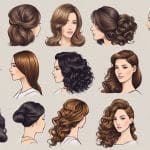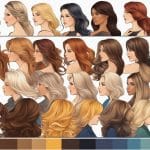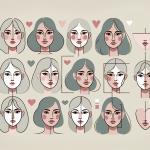Types Of Eyelids
Eyelids are an essential part of the eye as they protect the eyes from foreign objects and regulate the amount of light that enters. They also play a crucial role in the appearance of the eyes, with different eyelid types affecting the overall look. Understanding the different types of eyelids can help individuals choose the right makeup techniques and products for their eyes and address any eyelid concerns or conditions they may have.
The anatomy and function of the eyelids are complex, with several layers of skin, muscle, and connective tissue working together. The eyelids have meibomian glands that secrete oils to keep the eyes lubricated and prevent dryness. The eyelashes, which grow from the eyelids, also play a role in protecting the eyes from debris and dust.
Common eyelid types include monolids, double eyelids, hooded eyelids, tapered eyelids, and parallel eyelids. Each type has its unique characteristics and requires different makeup techniques to enhance the eyes’ appearance. Certain eyelid concerns and conditions, such as ptosis or droopy eyelids, may also affect the eyelids’ appearance and require specialized care.
Key Takeaways
- Understanding the anatomy and function of the eyelids is crucial to caring for them properly.
- Different eyelid types require different makeup techniques to enhance their appearance.
- Addressing eyelid concerns and conditions may require specialized care.
Anatomy and Function of Eyelids

The eyelids are crucial structures that protect and maintain the health of the eyes. They are composed of several layers of tissue that work together to provide structure, moisture, and protection to the eyes. In this section, we will discuss the anatomy and function of eyelids in detail.
Layers and Structure
The eyelids consist of several layers of tissue, including skin, connective tissue, muscle, and mucous membrane. The skin of the eyelids is thin and contains sebaceous glands, which produce oil to help keep the skin lubricated. Beneath the skin is a layer of dense connective tissue, which provides structure and support to the eyelids. The tarsal plates, which are made of dense connective tissue, are located within the upper and lower eyelids and help maintain the shape of the eyelids.
Muscles and Glands
The muscles of the eyelids are responsible for opening and closing the eyes. The orbicularis oculi muscle is a circular muscle that encircles the eye and is responsible for closing the eyelids. The levator palpebrae superioris muscle is responsible for opening the upper eyelid. The superior tarsal muscle, which is located within the upper eyelid, helps to raise the eyelid.
The eyelids also contain several types of glands, including the lacrimal, meibomian, and sweat glands. The lacrimal gland produces tears, which help to lubricate and protect the eyes. The meibomian glands produce oil, which helps to prevent evaporation of tears. The sweat glands produce sweat, which helps to cool the skin of the eyelids.
Innervation and Blood Supply
The eyelids are innervated by several nerves, including the ophthalmic nerve, which provides sensory innervation to the upper eyelid, and the maxillary nerve, which provides sensory innervation to the lower eyelid. The oculomotor nerve is responsible for innervating the levator palpebrae superioris muscle.
The eyelids are supplied with blood by several arteries, including the ophthalmic artery, which supplies blood to the upper eyelid, and the facial artery, which supplies blood to the lower eyelid. Venous drainage is provided by the lateral palpebral vein.
In conclusion, the eyelids are complex structures that perform several important functions to protect and maintain the health of the eyes. Understanding the anatomy and function of eyelids is crucial for maintaining good eye health.
Common Eyelid Types
When it comes to eyelids, there are various types, each with its unique characteristics. In this section, we will discuss the most common eyelid types, including monolids and double eyelids, hooded eyelids, and other variations.
Monolids and Double Eyelids
Monolids and double eyelids are the most common eyelid types, particularly in East Asian countries. Monolids, also known as single eyelids, lack a crease, making the lid appear as a single fold extending to the brow bone. On the other hand, double eyelids have a crease, dividing the lid into two parts.
Makeup application differs for both eyelid types, with monolids requiring more emphasis on the lash line and double eyelids requiring more focus on the crease. Double eyelids are also more versatile when it comes to eye makeup, allowing for more experimentation with different looks.
Hooded Eyelids
Hooded eyelids are characterized by excess skin that folds over the crease, making the lid appear smaller. This type of eyelid is more common among older individuals, but it can also be seen in younger people.
Makeup application for hooded eyelids requires a different approach, with emphasis on the outer corner of the eye to create the illusion of a more open eye. Additionally, using a lighter shade on the lid and a darker shade on the crease can help create depth and definition.
Other Variations
Other variations of eyelids include tapered eyelids, which have a narrow inner corner and wider outer corner, and parallel eyelids, which have a straight crease. Additionally, some people have an epicanthic fold, which is a skin fold that covers the inner corner of the eye, creating a distinct eye shape.
Overall, understanding your eyelid type can help you determine the best makeup techniques to enhance your natural features.
Eyelid Concerns and Conditions
The eyelids are an important part of the eye, protecting it from dust and other foreign objects. While they are essential for eye health, the eyelids can also be a source of cosmetic and medical concerns.
Cosmetic Considerations
Many people are concerned with the appearance of their eyelids. Makeup tips and tricks can be used to enhance the natural beauty of the eyes. Eyeliner can be used to create the appearance of a cat eye or to make the eyes appear larger. Primer can be used to help eyeshadow stay in place, and setting powder can be used to prevent creasing.
For those looking for a more permanent solution, blepharoplasty is a surgical procedure that can be used to remove excess skin and fat from the eyelids. Eyelid tape can also be used to create the appearance of a more lifted eyelid.
Medical Issues
Ptosis, or drooping of the eyelid, can be caused by a variety of factors including age, injury, and neurological conditions. Styes and chalazion are common eyelid infections that can cause pain and discomfort.
The palpebral aperture, or opening between the eyelids, can also be a source of medical concerns. Insufficient lubrication can cause dry eye syndrome, while an overproduction of oil from the ciliary glands of Moll can cause oily substance buildup.
Sagittal section of the eyelid can reveal information about the structure and function of the eyelids. Downturned and almond-shaped eyelids are common variations in eyelid shape that can affect the appearance of the eyes.
Overall, it is important to seek medical attention if you experience any pain or discomfort in the eyelids.
Makeup Techniques for Different Eyelids
Enhancing Eye Shape with Makeup
Makeup can be a powerful tool to enhance the beauty of different types of eyelids. For monolids, applying a light-colored eyeshadow on the lid and a darker shade on the crease can help create the illusion of depth. For double eyelids, a gradient eyeshadow technique can be used to create a natural-looking dimension. Hooded eyelids can be accentuated with a winged eyeliner to lift the eyes and create a dramatic effect. Tapered eyelids can be enhanced with a smoky eyeshadow look to create an illusion of roundness.
To further enhance the eye shape, applying eyeliner can be helpful. For monolids, a thin line of eyeliner on the upper lash line can help define the eyes. Double eyelids can benefit from a thicker winged eyeliner to create a more dramatic look. Hooded eyelids can be accentuated with a thicker line of eyeliner on the upper lash line, creating the illusion of a larger eye. Tapered eyelids can be enhanced with a smudged line of eyeliner on the upper lash line to create a softer look.
Tips for Long-Lasting Eyelid Makeup
To ensure the longevity of eyelid makeup, it is important to use a primer before applying eyeshadow. A primer helps to create a smooth base for eyeshadow and prevents it from creasing. Setting powder can also be used to set the eyeshadow in place and prevent it from smudging.
When applying mascara, it is important to focus on the upper lashes to create a lifted effect. Wiggle the mascara wand at the base of the lashes and pull upwards to create volume and length. For double eyelids, curling the lashes can help create a more open-eyed look.
Overall, with the right technique and products, makeup can be used to enhance the beauty of different types of eyelids. By following these tips, anyone can achieve a stunning eye makeup look that lasts all day.
Caring for Your Eyelids
Taking care of your eyelids is essential for maintaining their health and appearance. Proper care can prevent common eyelid problems such as inflammation, infection, and dryness.
One of the most important things you can do to care for your eyelids is to keep them clean. Wash your face regularly and use a gentle cleanser to remove any dirt, oil, or makeup from your eyelids. Avoid using harsh soaps or scrubbing too hard, as this can irritate your skin and damage your eyelid follicles.
In addition to cleaning your eyelids, it’s important to keep them hydrated. Drinking plenty of water can help keep your skin and eyelids moisturized and healthy. You can also use a moisturizer specifically designed for the eye area to help prevent dryness.
Another way to care for your eyelids is to protect them from the sun. Wearing sunglasses with UV protection can help prevent damage to your eyelid skin and reduce your risk of developing skin cancer.
Finally, if you wear makeup, it’s important to choose products that are gentle and non-irritating. Avoid using waterproof or long-lasting formulas, which can be difficult to remove and may irritate your skin. Always remove your makeup before going to bed to prevent buildup and infection.
By following these simple steps, you can help keep your eyelids healthy and looking their best.






